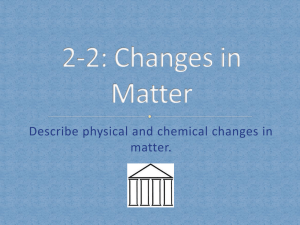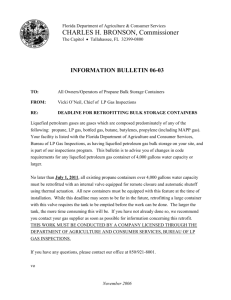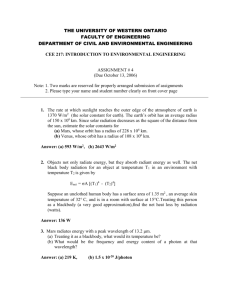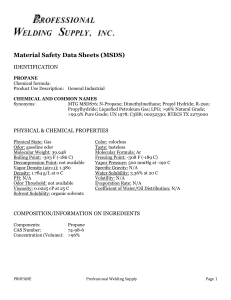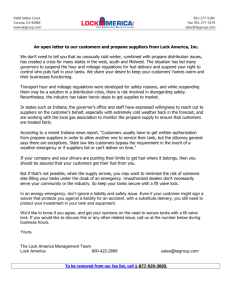Commercial Propane (Odorized)
advertisement
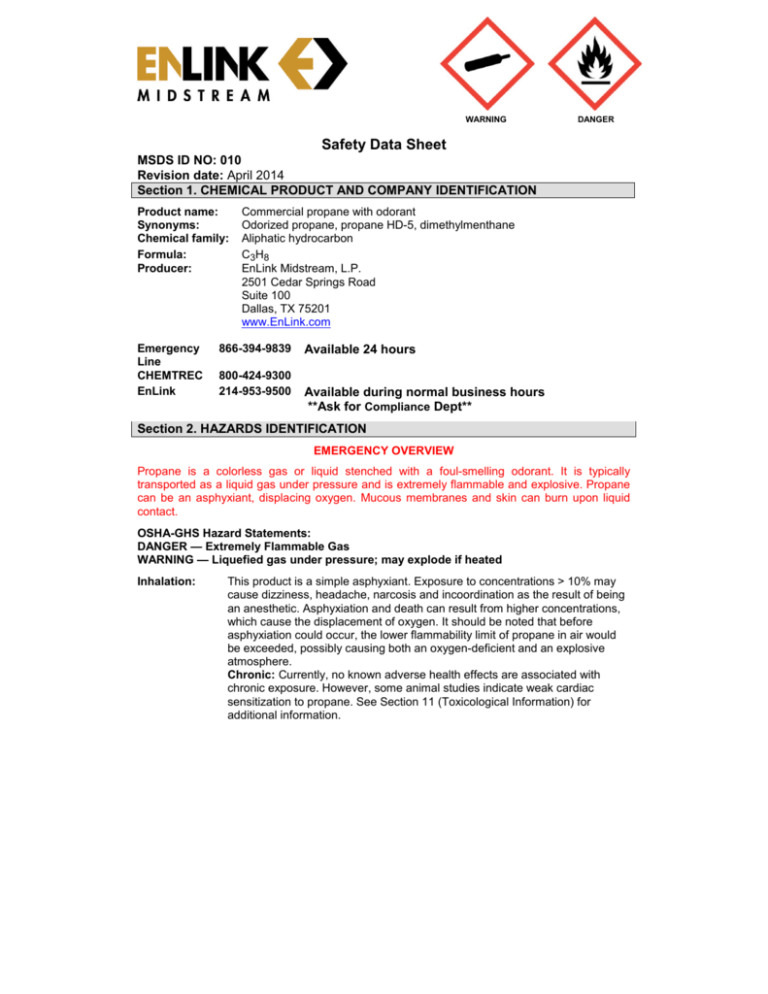
WARNING DANGER Safety Data Sheet MSDS ID NO: 010 Revision date: April 2014 Section 1. CHEMICAL PRODUCT AND COMPANY IDENTIFICATION Product name: Synonyms: Chemical family: Formula: Producer: Emergency Line CHEMTREC EnLink Commercial propane with odorant Odorized propane, propane HD-5, dimethylmenthane Aliphatic hydrocarbon C 3H 8 EnLink Midstream, L.P. 2501 Cedar Springs Road Suite 100 Dallas, TX 75201 www.EnLink.com 866-394-9839 800-424-9300 214-953-9500 Available 24 hours Available during normal business hours **Ask for Compliance Dept** Section 2. HAZARDS IDENTIFICATION EMERGENCY OVERVIEW Propane is a colorless gas or liquid stenched with a foul-smelling odorant. It is typically transported as a liquid gas under pressure and is extremely flammable and explosive. Propane can be an asphyxiant, displacing oxygen. Mucous membranes and skin can burn upon liquid contact. OSHA-GHS Hazard Statements: DANGER — Extremely Flammable Gas WARNING — Liquefied gas under pressure; may explode if heated Inhalation: This product is a simple asphyxiant. Exposure to concentrations > 10% may cause dizziness, headache, narcosis and incoordination as the result of being an anesthetic. Asphyxiation and death can result from higher concentrations, which cause the displacement of oxygen. It should be noted that before asphyxiation could occur, the lower flammability limit of propane in air would be exceeded, possibly causing both an oxygen-deficient and an explosive atmosphere. Chronic: Currently, no known adverse health effects are associated with chronic exposure. However, some animal studies indicate weak cardiac sensitization to propane. See Section 11 (Toxicological Information) for additional information. Ingestion: An unlikely route of exposure. This product is a gas under normal atmospheric conditions, but frostbite of the lips and mouth may result from contact with the liquid. Skin contact: Liquid may cause frostbite, a cryogenic injury resembling a burn. Eye contact: Gas is relatively non-irritating to eyes, but the liquid may cause frostbite. Carcinogenic evaluation: No component of this product present at levels greater than 0.1 % is identified as a known, suspected or potential carcinogen by the NTP, the IARC or OSHA. Section 3. COMPOSITION / INFORMATION ON INGREDIENTS Propane is an aliphatic petroleum hydrocarbon. Ethyl mercaptan (15-25 ppm) is added as an odorant. The odor threshold of the mercaptan is 1 ppb. Material information: Name Propane* Ethane* Iso-butane N-butane CAS No. Weight % 74-98-6 74-84-0 75-28-5 106-97-8 90-100 0-5.0 0.20-7.0 0.01-0.20 Note: The above weight percentages are represented in ranges as estimates. Due to variations in feedstock sources, components of propane may vary. Section 4. FIRST AID MEASURES Inhalation: Move exposed persons to fresh air. If the person is not breathing or breathing is irregular, provide artificial respiration or oxygen by trained personnel. Seek immediate medical attention. Skin contact: For exposure to liquid, immediately warm frostbite area with warm water not to exceed 105°F (41°C). In case of massive exposure, remove contaminated clothing while showering with warm water. Call a physician. Ingestion: An unlikely route of exposure. This product is a gas a normal temperature and pressure. Eye contact: Check for and remove any contact lenses. Immediately consult physician after flushing eyes with tepid water for at least 15 minutes. Section 5. FIREFIGHTING MEASURES Suitable extinguishing media: Small fires — Class B fire-extinguishing media including CO2 or dry chemicals can be used. Larger fires — water spray, fog. Use of extinguishers should be undertaken only by adequately trained personnel. Specific hazards: Refer to NFPA 30 or North American Emergency Response Guide 115. Special protective equipment for firefighters: If possible, stop product flow and allow it to burn out. The fire should not be extinguished unless flow of gas can be immediately stopped. Product can produce both internal/external explosions in any vessel if Bleve’s point is reached. Extinguishing flame may lead to formation of other dangerous mixtures. Extinguishing flame may lead to formation of other dangerous mixtures. Prevent runoff from fire control or dilution from entering streams, sewers or drinking water supply. CAUTION — Contact with water and other liquefied product can cause increased vaporization. EnLink Midstream LP Propane with Odorant Page 2 of 6 FIRE NFPA rating: Health: Flammability: Instability/reactivity: Other: 1 4 0 N/A H E A L T H 1 4 0 R E A C T I V I T Y Slightly Hazardous FP - Below 73 F Stable N/A SPECIAL Section 6. ACCIDENTAL RELEASE MEASURES Personal precautions: Immediately contact emergency personnel. Evacuate any potentially affected area and isolate personnel from entry. Isolate the area until gas has dispersed. Use suitable personal protective equipment (Section 8). Shut off source if possible and if safe. Vapor can collect in lower areas. Advise applicable authorities if material has entered sewers or water courses. Section 7. HANDLING AND STORAGE Handling: Ensure proper grounding methods are used in the handling of this product. Comply with 29 CFR 1910.110, “Storage and Handling of Liquefied Petroleum Gases,” and all other applicable regulatory agencies related to environmental, health and safety. Hydrocarbon liquids, including this product, can act as a non-conductive flammable liquid (or static accumulator) and may form ignitable vapor-air mixtures in storage tanks or other containers. For more information on precautions to prevent static-initiated fire or explosion, see NFPA 77, “Recommended Practice, Protection Against Static Electricity.” Section 8. EXPOSURE CONTROLS / PERSONAL PROTECTION Occupational Exposure Limits: Name CAS No. ® ® ACGIH TLV exposure limits: Federal OSHA PELs Propane 74-98-6 1000 ppm A 1000 ppm Ethane N-butane 74-84-0 106-97-8 1000 ppm 1000 ppm A None None Iso-butane 75-28-5 1000 ppm A A None B OSHA PELs 1989 and NIOSH RELs B 1000 ppm 3 1800 mg/m None 3 B 1900 mg/m 800 ppm 3 B 1900 mg/m 800 ppm All exposure limits listed are 8-hour time weighted average (TWA) — except where noted otherwise. TWA — Time Weighted Average is an average value of exposure over the course of an 8-hour work shift. A Time-Weighted Average (TWA) aliphatic hydrocarbon gas (alkane C 1-C4) PEL — Permissible Exposure Limit is the maximum amount or concentration of a chemical that a worker may be exposed to under OSHA regulations. B Federal OSHA 1989 PELs were vacated but are in use and enforced by many state OSHA plans. Engineering measures: Ensure proper ventilation and methods of exhaust are operating to reduce potential hazards. Ensure all equipment is intrinsically safe or explosion-proof and approved for classified areas. PERSONAL PROTECTIVE EQUIPMENT Respiratory protection: EnLink Midstream LP If product levels are detected in the applicable ranges, use NIOSH/ MSHA-approved positive pressure supplied air respirators. Propane with Odorant Page 3 of 6 Skin and body protection: Cover exposed skin areas with appropriate personal protection coverings. Eye protection: Ensure proper use of goggles and/or face shields in handling of any pressurized gases or materials. Hygiene measures: Avoid repeated or prolonged skin exposure. Wash hands before eating, drinking, smoking, or using toilet facilities. Promptly remove contaminated clothing and launder before reuse. Section 9. PHYSICAL AND CHEMICAL PROPERTIES Appearance: Physical state (solid/liquid/gas): Substance type (pure/mixture): Color: Odor: Molecular weight: pH: Boiling point/range (5-95%): Melting point/range: Decomposition temperature: Specific gravity: Vapor density: Vapor pressure: Evaporation rate: Flash point: Auto-ignition temperature: Flammable limits in air — lower (%): Flammable limits in air — upper (%): Colorless liquefied gas Liquid Mixture Colorless N/A 44 N/A -43.7°F -305.8°F N/A 0.59 1.6 190-205 PSIA at 100°F N/A -156°F 871°F 2.1 9.5 Section 10. STABILITY AND REACTIVITY Stability: Polymerization: Hazardous decomposition products: Materials to avoid: Conditions to avoid: The material is stable at 70°F, 182 psi. Will not occur. Carbon monoxide Strong oxidizers such as nitrates, perchlorates, chlorine, fluorine Sources of heat/ignition Section 11. TOXICOLOGICAL INFORMATION Acute toxicity: Product information: Name Propane CAS No. 74-98-6 Inhalation: LC50 > 550,000 ppm (guinea pigs) Dermal: N/A Oral: N/A LC50 — The concentration of the chemical in air that kills 50% of the test animals in a given time (usually four hours) Sensitization: Propane is not known to cause sensitization in humans; however, some animal studies indicate that exposure to propane can cause weak cardiac sensitization. EnLink Midstream LP Propane with Odorant Page 4 of 6 Section 12. ECOLOGICAL INFORMATION Ecotoxicity effects: Products of degradation: Not toxic to aquatic life/waterfowl. Aquatic 96-hour TLm for propane > 100 ppm (TLm — Median Threshold Limit) Products of degradation: carbon oxides (CO, CO2 and water) Section 13. DISPOSAL CONSIDERATIONS Cleanup considerations: Disposal of this material must be done in accordance with federal, state and/or local regulations. The material destined for disposal must be characterized properly and may differ from the product described in this MSDS if mixed with other wastes. Section 14. TRANSPORT INFORMATION Please refer to 40 CFR 172.101: DOT: Transport information: This material is regulated under DOT when transported via U.S. commerce routes. Proper shipping name: Propane UN/identification no.: UN 1075 Hazard class: 2.1 Packing group: N/A DOT reportable quantity (lbs): N/A Section 15. REGULATORY INFORMATION U.S. federal regulatory information: State and community right-to-know regulations: The following component(s) of this material are identified on the regulatory lists below: U.S. TSCA Chemical inventory Section 8(b) OSHA — This product is determined to be hazardous as defined in the OSHA Hazard Communications Standard. CERCLA Sections 102a/103 (40 FR 302.4): SARA Title III Section 302 — N/A SARA Title III Section 304 — N/A SARA Title III Section 313 — N/A SARA Title III Sections 311/312 Hazardous Categories (40 CFR 370.21) ACUTE: CHRONIC: FIRE: REACTIVE: SUDDEN RELEASE: HEALTH HAZARD NO FIRE HAZARD NO SUDDEN RELEASE OF PRESSURE NOTE: User must consult with applicable state and local agencies for special specifics, determinations or compliance obligations regarding this product. Section 16. OTHER INFORMATION The information and recommendations contained herein are based upon tests, data, and information resources believed to be reliable. However, EnLink Midstream, L.P., and its EnLink Midstream LP Propane with Odorant Page 5 of 6 related operations or divisions (EnLink) do not guarantee the accuracy or completeness, nor shall any of this information constitute a warranty, whether expressed or implied, as to the safety of goods, the merchantability of the goods or the fitness of the goods for a particular purpose. Adjustment to conform to actual conditions of usage may be required. EnLink assumes no responsibility for results obtained or for incidental or consequential damages, including lost profits, arising from the use of this data. No warranty against infringement of any patent, copyright or trademark is made or implied. EnLink Midstream LP Propane with Odorant Page 6 of 6
